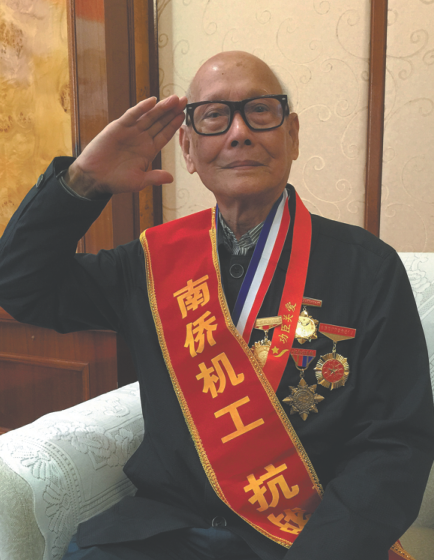 |
|
Jiang Yinsheng, a volunteer driver, was one of more than 8 million overseas Chinese who came to China's aid in the fight against the Japanese occupation. TAN YINGZI/CHINA DAILY |
When China was fighting for its life during the Japanese occupation, more than 8 million overseas Chinese from across the world who rallied to help the country.
Among them, about 3,800 drivers and mechanics from countries in Southeast Asian volunteered to return to China to assist with transportation on the Burma Road, the country's only lifeline for international aid at the time.
Although more than 30 percent of the volunteers were killed on the dangerous 1,154-km mountain highway between 1939 and 1942, the operation transported nearly 500,000 metric tons of military supplies to China from Myanmar, then known as Burma, an average of 300 tons a day.
When the war ended, about 1,000 of the survivors returned to their families, while the rest stayed in China.
Only seven of those who stayed are still alive. Jiang Yinsheng, 88, is the youngest and healthiest of them, and he will represent the Southeast Asian mechanics and drivers at the Sept 3 celebrations in Beijing to mark the 70th anniversary of the victory.
"I'm so excited that I can't sleep well these days," he said, speaking at his home in Chongqing, Southwestern China, on Monday, ahead of his trip to the capital.
Born into a wealthy Chinese family in Kolkata, India, Jiang already had a deep understanding of his homeland when the war with Japan started in 1937.
"My father always told me that if our motherland was weak and poor, we overseas Chinese would also be looked down upon, no matter how wealthy we were," he said.
As a child, Jiang often traveled with his businessman father to countries such as Australia and New Zealand, and he remembers the strong anti-Chinese feeling.
"When we were at customs, the clerks were really rude to us and threw our passports back at us. Discrimination against Chinese was very obvious at that time," he said.
In 1939, China was in dire need of drivers and mechanics to transport military supplies via the Burma Road. Tan Kah Kee, aka Chen Jiageng, a well-known wartime leader of the Chinese community in Southeast Asia, encouraged overseas Chinese mechanics to join the battle.
The 13-year-old Jiang volunteered without telling his parents and headed for China along with four classmates. As members of the ninth group of volunteers, the schoolboys traveled via Singapore, Vietnam and finally arrived at Kunming in Southwest China's Yunnan province.
"My only thought at the time was to fight the Japanese invaders and save China," he said. "I never thought about my own life."
He became a driver because his older brother, a doctor in India, had a car, and Jiang had taught himself to drive as a primary school student.
"I was really bold. I always 'stole' my brother's car and drove," he said.
After a month's training in Kunming, Jiang was recruited by the Overseas Chinese Pioneers Team at the Kunming Transportation Bureau and quickly started working on the Burma Road.
Because he was short in stature, Jiang had to sit on two cushions to reach the steering wheel, but even so, "it looked as if there was no one driving the truck", he said.
The construction of the road, built by 200,000 Burmese and Chinese laborers, began in 1937 and ended in 1938. Japan had occupied China's coastal cities, so the Burma Road was the only way to transport international aid into the country.
The Japanese usually conducted air raids on the convoys during daylight hours, so the trucks moved under cover of darkness, with two people walking ahead stretching a meter-long piece of white cloth between them to indicate the route to follow.
"To hide from the air raids, we had to turn off the lights and follow the white cloth," Jiang said, adding that his truck could only travel about 200 km a day, so the journey to Kunming took about five days. "The road was very narrow and dangerous," he said.
During air raids, the Japanese usually blocked the roads by bombing the first truck in the convoy, so the drivers had to push the damaged truck off the road before they could proceed. "Then we buried the bodies of our comrades at the side of the road," he said.
When the Japanese overran Burma in 1942, the road became unusable, so Jiang was transferred to the US Relief and Aid Bureau in Kunming, where he also worked as a driver and was able to use his English language skills.
In 1949, he joined the People's Liberation Army, and served as a driver in the Tibet autonomous region from 1950 to 1958, when he left the PLA.
After he left the army, he lived in Chongqing, where he married and had a son and two daughters, and worked for a transportation company in the Yongchuan district of the city.